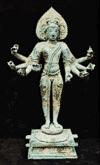- South Indian bronze
-
Any of the cult images that rank among the finest achievements of Indian visual art.Most of the figures represent Hindu divinities, especially various iconographic forms of the god Shiva and Lord Vishnu, with their consorts and attendants. The images were produced in large numbers from the 8th to the 16th century, principally in the Thanjavur and Tiruchchirappalli districts of modern Tamil Nadu, and maintained a high standard of excellence for almost 1,000 years. The icons range from small household images to almost life-size sculptures intended to be carried in temple processions.
 The god Śiva in the garb of a mendicant, South Indian bronze from Tiruvengādu, Tamil ...P. Chandra
The god Śiva in the garb of a mendicant, South Indian bronze from Tiruvengādu, Tamil ...P. Chandra* * *
▪ artany of the cult images of Hindu divinities that rank among the finest achievements of Indian visual art. The images were produced in large number from the 8th to the 16th century, principally in the Thanjāvūr and Tiruchchirāppalli districts of modern Tamil Nadu, and maintained a high standard of excellence for almost 1,000 years.During the Pallava (Pallava Dynasty) period, metal sculpture closely followed the canons of contemporary stone sculpture, and the images were almost invariably frontal, though modelled fully in the round, with arms held symmetrically to either side. A greater fluidity of movement is apparent in images of the early Cōla period (10th–11th century AD), and the movements and hand gestures of dance are frequently employed. The Cōla images are unsurpassed in their elegance, sensitive modelling, and balanced tension. During the Vijayanagar period (1336–1565) the ornamentation tended to become more elaborate, interfering with the smooth rhythm of the body, and the postures became more rigid.The icons range from small household images to almost life-size sculptures intended to be carried in temple processions. A few Buddhist and Jaina images were produced, but the figures mostly represent Hindu divinities, especially various iconographic forms of the god Śiva and Lord Vishnu, together with their consorts and attendants. Also of outstanding quality are the many images of Śiva and Vaiṣṇava saints (the Āḻvārs).The images are cast by the cire-perdue, or lost-wax, process lost-wax process) (lost-wax process). Final sculptural touches are added to the image after it is cast, with the result that the images are “carved” as well as “modelled.” Important collections of South Indian bronzes are housed in the Thanjāvūr Museum and Art Gallery, in Tamil Nadu, and at the Government Museum in Madras, but the largest number of fine images are in the various temples of southern India.* * *
Universalium. 2010.
